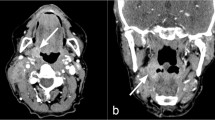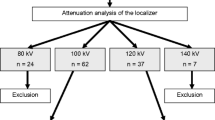Abstract
Purpose
To evaluate image quality and radiation dose in third-generation dual-source computed tomography (DSCT) of the neck using automated tube voltage adaptation (TVA) with advanced modelled iterative reconstruction (ADMIRE) algorithm.
Methods
One hundred and sixteen patients were retrospectively evaluated. Group A (n = 59) was examined on second-generation DSCT with automated TVA and filtered back projection. Group B (n = 57) was examined on a third-generation DSCT with automated TVA and ADMIRE. Age, body diameter, attenuation of several anatomic structures, noise, signal-to-noise ratio (SNR), contrast-to-noise ratio (CNR), radiation dose (CTDIvol) and size-specific dose estimates (SSDE) were assessed. Diagnostic acceptability was rated by three readers.
Results
Age (p = 0.87) and body diameter (p = 0.075) did not differ significantly. Tube voltage in Group A was set automatically to 100 kV for all patients (n = 59), and to 70 kV (n = 2), 80 kV (n = 5), and 90 kV (n = 50) in Group B. Noise was reduced and CNR was increased significantly (p < 0.001). Diagnostic acceptability was rated high in both groups, with better ratings in Group B (p < 0.001). SSDE was reduced by 34 % in Group B (20.38 ± 1.63 mGy vs. 13.04 ± 1.50 mGy, p < 0.001).
Conclusion
Combination of automated TVA and ADMIRE in neck CT using third-generation DSCT results in a substantial radiation dose reduction with low noise and increased CNR.
Key Points
• Third-generation DSCT provides automated tube voltage adaptation with an increment of 10 kV.
• 10 kV increment optimizes scans to the patient’s neck anatomy.
• TVA combined with ADMIRE significantly lower radiation dose in contrast-enhanced neck CT.
• TVA in combination with ADMIRE reduces noise and increases SNR and CNR.
• Image analysis quoted less noise and better diagnostic acceptability in third-generation DSCT.




Similar content being viewed by others
Abbreviations
- ADMIRE:
-
Advanced modelled iterative reconstruction
- AP:
-
Anterior-posterior
- CNR:
-
Contrast-to-noise ratio
- CT:
-
Computed tomography
- CTDIvol :
-
CT dose index volume
- DSCT:
-
Dual-source computed tomography
- HU:
-
Hounsfield units
- ICC:
-
Intraclass correlation coefficient
- IJV:
-
Internal jugular vein
- LAT:
-
Lateral
- ROI:
-
Region of interest
- SD:
-
Standard deviation
- SNR:
-
Signal-to-noise ratio
- SSDE:
-
Size-specific dose estimates
- TCM:
-
Tube current modulation
- TVA:
-
Tube voltage adaptation
References
Berrington de Gonzalez A, Mahesh M, Kim KP et al (2009) Projected cancer risks from computed tomographic scans performed in the United States in 2007. Arch Intern Med 169(22):2071–2077
Brenner DJ (2010) Slowing the increase in the population dose resulting from CT scans. Radiat Res 174(6):809–815
Brenner DJ, Hall EJ (2007) Computed tomography--an increasing source of radiation exposure. N Engl J Med 357(22):2277–2284
Brenner DJ, Doll R, Goodhead DT et al (2003) Cancer risks attributable to low doses of ionizing radiation: assessing what we really know. Proc Natl Acad Sci U S A 100(24):13761–13766
Odedra D, Blobel J, Alhumayyd S et al (2014) Image noise-based dose adaptation in dynamic volume CT of the heart: dose and image quality optimisation in comparison with BMI-based dose adaptation. Eur Radiol 24(1):86–94
Scholtz JE, Kaup M, Husers K et al (2015) Advanced modeled iterative reconstruction in low-tube-voltage contrast-enhanced neck ct: evaluation of objective and subjective image quality. AJNR Am J Neuroradiol
Scholtz JE, Wichmann JL, Husers K et al (2015) Automated Tube Voltage Adaptation in Combination with Advanced Modeled Iterative Reconstruction in Thoracoabdominal Third-Generation 192-Slice Dual-Source Computed Tomography: Effects on Image Quality and Radiation Dose. Acad Radiol 22(9):1081–1087
Greess H, Wolf H, Baum U et al (2000) Dose reduction in computed tomography by attenuation-based on-line modulation of tube current: evaluation of six anatomical regions. Eur Radiol 10(2):391–394
Kalender WA, Wolf H, Suess C et al (1999) Dose reduction in CT by on-line tube current control: principles and validation on phantoms and cadavers. Eur Radiol 9(2):323–328
Lopez-Rendon X, Bosmans H, Oyen R, Zanca F (2015) Effective dose and organ doses estimation taking tube current modulation into account with a commercial software package. Eur Radiol 25(7):1919–1925
May MS, Kramer MR, Eller A et al (2014) Automated tube voltage adaptation in head and neck computed tomography between 120 and 100 kV: effects on image quality and radiation dose. Neuroradiology 56(9):797–803
Brinkley MF, Ramirez-Giraldo JC, Samei E et al (2015) Effects of automatic tube potential selection on radiation dose index, image quality, and lesion detectability in pediatric abdominopelvic CT and CTA: a phantom study. Eur Radiol
Wichmann JL, Hu X, Kerl JM et al (2015) 70 kVp computed tomography pulmonary angiography: potential for reduction of iodine load and radiation dose. J Thorac Imaging 30(1):69–76
Scholtz JE, Husers K, Kaup M et al (2015) Evaluation of image quality and dose reduction of 80 kVp neck computed tomography in patients with suspected peritonsillar abscess. Clin Radiol
Scholtz JE, Kaup M, Kraft J et al (2015) Objective and subjective image quality of primary and recurrent squamous cell carcinoma on head and neck low-tube-voltage 80-kVp computed tomography. Neuroradiology 57(6):645–651
Gaddikeri S, Andre JB, Benjert J et al (2015) Impact of Model-Based Iterative Reconstruction on Image Quality of Contrast-Enhanced Neck CT. AJNR Am J Neuroradiol 36(2):391–396
Husarik DB, Schindera ST, Morsbach F et al (2014) Combining automated attenuation-based tube voltage selection and iterative reconstruction: a liver phantom study. Eur Radiol 24(3):657–667
Winklehner A, Gordic S, Lauk E et al (2015) Automated attenuation-based tube voltage selection for body CTA: Performance evaluation of 192-slice dual-source CT. Eur Radiol
Yu L, Li H, Fletcher JG, McCollough CH (2010) Automatic selection of tube potential for radiation dose reduction in CT: a general strategy. Med Phys 37(1):234–243
Medicine AAoPi (2011) Size Specific Dose Estimates (SSDE) in pediatric and adult body CT examinations. Report of the AAPM Tasck Group 204, College Park
Eller A, May MS, Scharf M et al (2012) Attenuation-based automatic kilovolt selection in abdominal computed tomography: effects on radiation exposure and image quality. Invest Radiol 47(10):559–565
Gnannt R, Winklehner A, Goetti R et al (2012) Low kilovoltage CT of the neck with 70 kVp: comparison with a standard protocol. AJNR Am J Neuroradiol 33(6):1014–1019
Goetti R, Leschka S, Baumuller S et al (2010) Low dose high-pitch spiral acquisition 128-slice dual-source computed tomography for the evaluation of coronary artery bypass graft patency. Invest Radiol 45(6):324–330
Hoang JK, Yoshizumi TT, Nguyen G et al (2012) Variation in tube voltage for adult neck MDCT: effect on radiation dose and image quality. AJR Am J Roentgenol 198(3):621–627
Schindera ST, Graca P, Patak MA et al (2009) Thoracoabdominal-aortoiliac multidetector-row CT angiography at 80 and 100 kVp: assessment of image quality and radiation dose. Invest Radiol 44(10):650–655
Wichmann JL, Kraft J, Noske EM et al (2014) Low-tube-voltage 80-kVp neck CT: evaluation of diagnostic accuracy and interobserver agreement. AJNR Am J Neuroradiol 35(12):2376–2381
Bodelle B, Klein E, Naguib NN et al (2014) Acute intracranial hemorrhage in CT: benefits of sinogram-affirmed iterative reconstruction techniques. AJNR Am J Neuroradiol 35(3):445–449
May MS, Wust W, Brand M et al (2011) Dose reduction in abdominal computed tomography: intraindividual comparison of image quality of full-dose standard and half-dose iterative reconstructions with dual-source computed tomography. Invest Radiol 46(7):465–470
Vardhanabhuti V, Riordan RD, Mitchell GR et al (2014) Image comparative assessment using iterative reconstructions: clinical comparison of low-dose abdominal/pelvic computed tomography between adaptive statistical, model-based iterative reconstructions and traditional filtered back projection in 65 patients. Invest Radiol 49(4):209–216
Gordic S, Desbiolles L, Stolzmann P et al (2014) Advanced modelled iterative reconstruction for abdominal CT: qualitative and quantitative evaluation. Clin Radiol 69(12):e497–e504
Acknowledgments
The scientific guarantor of this publication is Jan-Erik Scholtz. The authors of this manuscript declare relationships with the following companies: Ralf W. Bauer is on the speakers’ bureau of Siemens Healthcare, Computed Tomography division. The author did not analyze or control any data in this study. All other authors have nothing to disclose. The authors state that this work has not received any funding. The authors have significant statistical expertise. No complex statistical methods were necessary for this paper. Institutional Review Board approval was obtained. Written informed consent was waived by the Institutional Review Board. No study subjects or cohorts have been previously reported. Methodology: retrospective, diagnostic or prognostic study, performed at one institution.
Author information
Authors and Affiliations
Corresponding author
Rights and permissions
About this article
Cite this article
Scholtz, JE., Wichmann, J.L., Hüsers, K. et al. Third-generation dual-source CT of the neck using automated tube voltage adaptation in combination with advanced modeled iterative reconstruction: evaluation of image quality and radiation dose. Eur Radiol 26, 2623–2631 (2016). https://doi.org/10.1007/s00330-015-4099-z
Received:
Revised:
Accepted:
Published:
Issue Date:
DOI: https://doi.org/10.1007/s00330-015-4099-z




